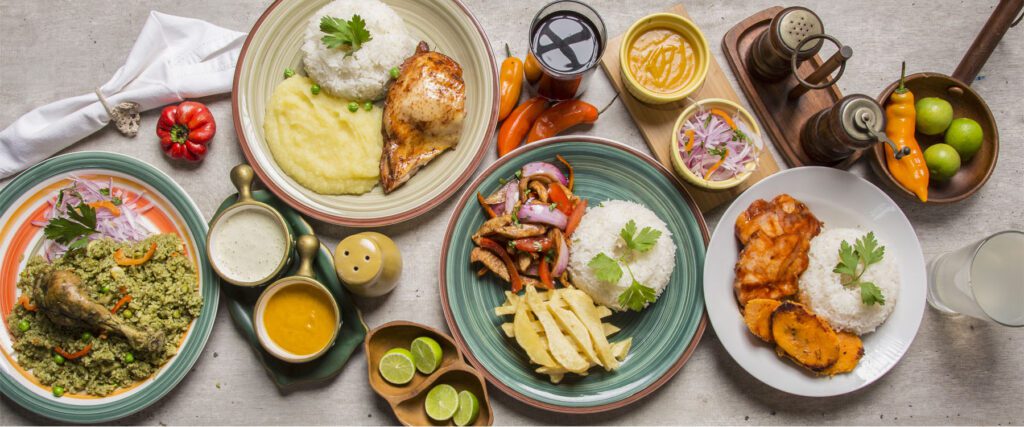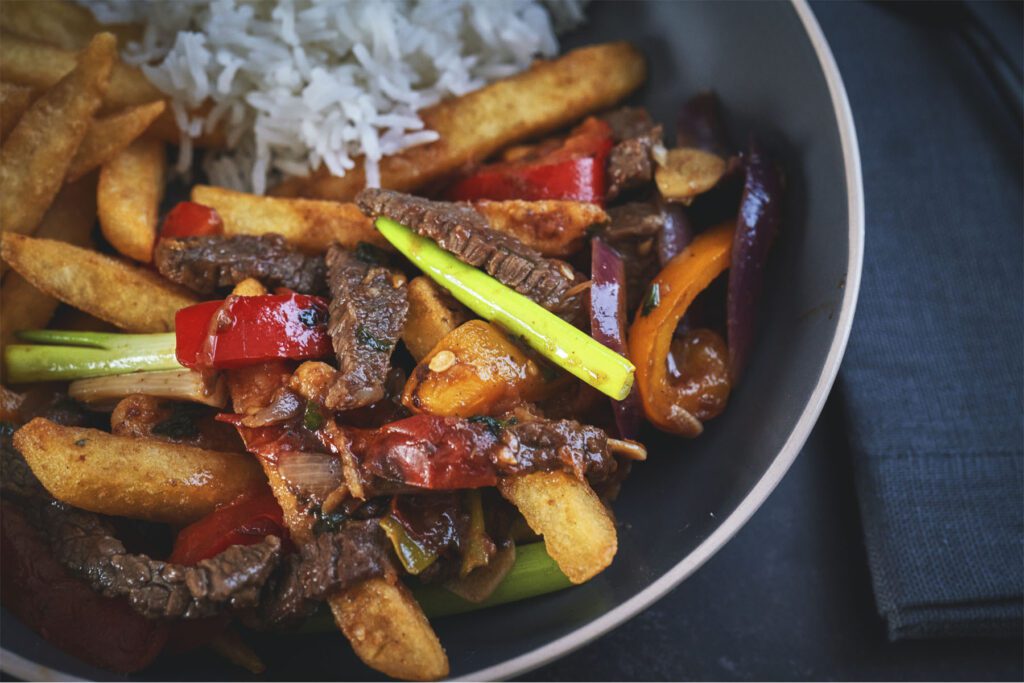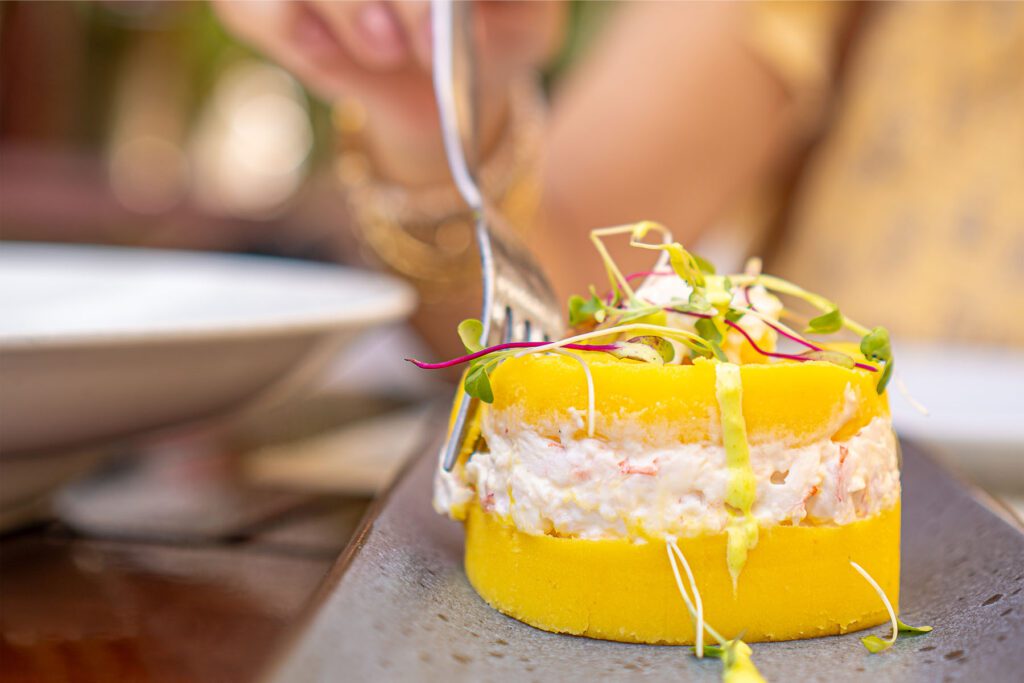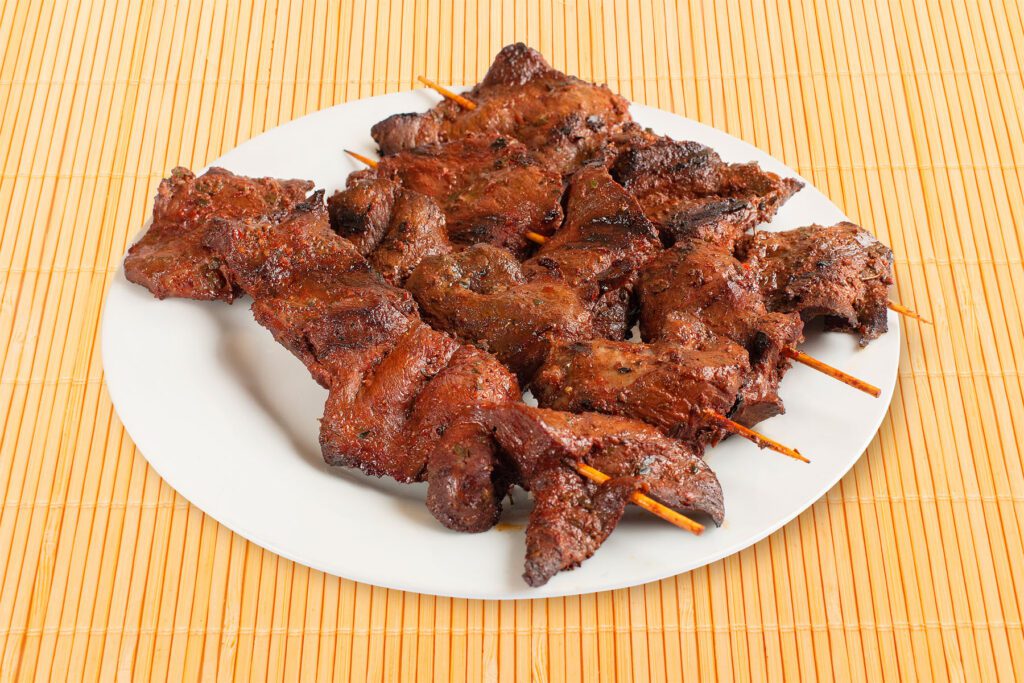Recently updated on July 28th, 2025 at 12:38 am
From the Pacific Ocean’s pounding surf beaches to the soaring Andes and Amazon beyond, Peru is a land of staggering contrasts. Nestled among them, World Heritage Machu Picchu, the buzzing cities of Lima, Arequipa and Cusco, and countless natural wonders and sacred sites, all vie for your attention. And as you work up an appetite exploring them, you’ll find these varied landscapes have shaped an equally diverse culinary scene, where food isn’t just celebrated, but is something of a national obsession. Consider this map your hitlist for tasting your way around the country.
Wherever your journey takes you, from the capital’s renowned cevicherías to the Lliklla-draped tables of the Sacred Valley, the family-run picanterías (spicy shops) of Arequipa and Iquitos’ traditional Amazon eateries, you’ll soon see that regionality and seasonality are key. Here ingredients change with altitude and climate – think quinoa and river fish in the highlands, plantains and yucca in the rainforest, and corn and chillies almost everywhere. And so is the influence of Peru’s many cultures – including the Quechua and Aymara peoples of the Andes, coastal Afro-Peruvian communities, and the highlands’ Incan descendants, along with the imprint of the Spanish, Japanese, Chinese and Italian migrants, shaping everything from stir-fries to stews. It all begins with the standout local produce: the country cultivates more than 4,000 varieties of native potatoes (papas) and at least 50 kinds of maize (maíz). Other staples include chillies (especially ají amarillo), Andean cheese, seafood, and meats ranging from alpaca (carne de alpaca) to guinea pig (cuy). Slow-cooked earth-oven feasts (pachamanca), wok-based sautés, charcoal grills and chilled raw foods are all part of the culinary mix.
So, to help you decode the local menus, and ensure your next South America holiday is a rewarding adventure for every sense, read on to discover exactly what to eat in Peru – and why you should try it all.


1. Ceviche – Peru’s National Dish
A zingy seafood salad, ceviche is a staple along the coast, especially in the capital, Lima, as well as Piura and Trujillo. It’s made from fresh, raw white fish – often sea bass or corvina – marinated in fresh lime juice, which light cooks the fish with citric acid rather than heat. Thinly sliced red onion, salt, and fiery ají limo or ají amarillo chillies are added for kick. It’s typically served with boiled sweet potato, cancha (toasted corn), and corn on the cob. Though variations exist across South America, Peru’s version is recognised by UNESCO for its significance to national heritage and is famed for the precision of its balanced flavours. Many Peruvians consider it a daytime dish as that’s when the daily catch is at its freshest.
2. Lomo Saltado – Stir-Fried Beef with Asian Influence
This wok-fried stir-fried beef dish is a staple of chifa cuisine, which has blended Peruvian and Chinese flavours since Cantonese migrants arrived in the 19th century. Strips of locally raised beef (often sirloin) are marinated in soy sauce, vinegar and spices; quickly stir-fried with red onions, coriander, tomatoes, ají amarillo chillis and sometimes capsicum; then traditionally served with both rice and thick-cut potato chips on the same plate. Though its roots are coastal, lomo saltado is found nationwide, everywhere from street stalls to contemporary fusion restaurants.
Our 14-day Authentic Peru holiday Makes Travel Matter by supporting social enterprises in the Sacred Valley, visiting key community markets, and more.


3. Aji de Gallina – Creamy Chicken Stew
This comforting classic is made by simmering shredded chicken in a smooth, mildly spicy sauce made from ají amarillo chillies, soaked bread or crackers, garlic, onions, milk, and fresh white cheese, and it’s usually served with sliced potato, rice and a hard-boiled egg. The stew is a staple of Peru’s cocina criolla – the Creole-style cuisine most common in Lima and along the coast – and its origins trace back to the 16th century colonia era, when Spanish stewing techniques and dairy products were introduced to across the coast and Andes. Over time, these European methods blended with Indigenous ingredients and were also influenced by African traditions, making for a tasty fusion of flavours.


4. Papas a la Huancaína – Potatoes in Spicy Cheese Sauce
This cold appetiser is another classic of cocina criolla, blending native Andean produce with colonial influences. Often associated with the central highlands around Huancayo, the dish is thought to have originated in Lima in the early 20th century. It features sliced yellow potatoes served chilled and smothered in a creamy sauce made from ají amarillo chilli, queso fresco, (a fresh cow’s milk cheese), evaporated milk and crushed crackers.
5. Cuy – Traditional Guinea Pig Dish
Cuy (guinea pig) has been a source of protein in the Andes for more than 5,000 years and is still culturally significant among Indigenous Quechua communities, particularly around Cusco, Puno and Arequipa. Unlike its status as a pet in many other countries, cuy is traditionally raised for food and is often served at family get-togethers and festivals. The meat is usually roasted or deep-fried whole (cuy chactado), and served with boiled potatoes, corn and sometimes ají sauce. While you’ll see it in rural markets and local eateries, upscale restaurants in Cusco and the Sacred Valley often give it the gourmet treatment: think deboned, pan-seared, or served confit-style. In rural villages, it’s sometimes prepared in pachamanca earth ovens alongside other meats and root vegetables.
Ready to explore Machu Picchu? Our collection of itineraries includes the classic Inca Trail trek, the challenging Salkantay route, a laidback-luxe rail adventure, and more.
6. Causa – Layered Potato Casserole
Made with layers of yellow potato spiced with ají amarillo and lime, and typically filled with tuna, chicken, avocado or seafood, this cold casserole has Quechua roots – its name is thought to come from kausay, meaning “life”– but the recipe evolved with Spanish and Creole culinary influences. The base, made from papa amarilla (a creamy native yellow variety), is lightly mashed, seasoned and pressed into a mould, and the filling is layered between it. Today the dish is found across the country, with coastal versions leaning towards tuna or shellfish, and inland regions going with chicken, avocado or boiled eggs.


7. Rocoto Relleno – Stuffed Spicy Peppers
Hailing from Arequipa in the south, this distinctive dish features rocoto – a fiery red chilli that looks like a capsicum but delivers a super-spicy kick. The rocoto is hollowed out and stuffed with a mix of minced beef or pork, onions, garlic, raisins, black olives and hard-boiled eggs. It’s then topped with a slice of cheese, baked until soft, and served with a potato gratin known as pastel de papa. Despite its regional origins, the dish is popular in the southern highlands and appears in both traditional picanterías (rustic, family-run eateries) and contemporary restaurants. Be warned, though – rocoto relleno packs some serious heat.
8. Anticuchos de Corazón – Grilled Beef Heart Skewers
Beef hearts are marinated in vinegar and spices, flame-cooked until tender, then served with boiled potatoes and choclo (giant Andean corn). This smoky delicacy dates back to the Spanish colonial period, when enslaved West and Central African people were brought to Peru. Denied not only their freedom but also prime cuts, they often made do with offal – including beef hearts – which they seasoned with native chillies like ají panca, garlic and cumin, fusing African culinary flair with Indigenous Peruvian ingredients. Originally a street food of Lima, anticuchos have become a staple across Peru, especially at markets and casual eateries.
Curious about Indigenous food traditions? Our Peruvian Amazon cruise visits a rainforest village, where friendly locals demonstrate how they grow and prepare jungle-fresh native produce.


9. Arroz con Pato – Duck with Cilantro Rice
This northern classic pairs Indigenous ingredients with colonial Spanish and Moorish cooking techniques. Duck leg or thigh is seared and then braised in garlic, spices and chicha de jora – a traditional fermented corn beer, which helps tenderise the meat and add richness. The rice is simmered separately, often in the same braising liquid, along with coriander (cilantro), ají amarillo chilli and garlic, which give it its distinctive green colour and fragrance. While variations appear across Peru, the dish is most common around Chiclayo and the Lambayeque region, where it’s still widely plated up for special occasions. You’ll find arroz con pato in family-run huariques (modest restaurants known for their homestyle cooking), traditional markets and high-end criollo restaurants.
10. Pollo a la Brasa – Peruvian Roasted Chicken
This beloved classic is so revered it even has its own national day of celebration – Día del Pollo a la Brasa (Peruvian Grilled Chicken Day) – every July. The chicken is first marinated in garlic, cumin, black pepper, soy sauce and ají panca chilli, then spit-roasted over charcoal or a wood-fired rotisserie for about an hour. Affordable and satisfying, it’s often served with thick-cut chips, salad and a side of ají sauce, and is a staple at pollerías (chicken restaurants) throughout Peru.
Our 11-day Insider Peru holiday is a fascinating immersion in its culture and ancient wonders, taking in the highlights of Lima, the Sacred Valley, World Heritage-listed Cusco, and beyond.
11. Butifarra – Pork Sandwich with Salsa Criolla
This simple, satisfying sandwich originated in the capital, where it’s long been a comfort-food classic for lunchtime and late-night bites, served in sangucherías (sandwich shops) and street stalls. It’s made with slices of jamón del país (country-style pork) and served in a crusty white bread roll; the meat is marinated in cumin, garlic, and aji panca chilli then slow-cooked until tender. What makes the sandwich stand out is its generous topping of salsa criolla – a zingy mix of red onion, lime juice, and chilli.
12. Arroz con Mariscos – Peruvian Seafood Rice
While it reflects its colonial roots, this dish is unmistakably Peruvian, incorporating local chillies, native herbs and regional seafood in the country’s coastal answer to Spanish paella. This rich seafood rice dish typically features a mix of Pacific Ocean prawns, squid, scallops, mussels and sometimes white fish, all sautéed with garlic, onions, ají amarillo and nají panca chillies. The seafood mixture is then simmered with short-grain rice in a seasoned stock and finished with a squeeze of lime and fresh coriander. The dish is most common on the coast, especially in Lima, Callao, and northern cities like Piura and Trujillo, where it’s a popular highlight a family-run eateries, cevicherías and marisquerías (seafood restaurants).


13. Fried Yucca – Crispy Cassava Fries
Fried yucca, known locally as yuca frita, is a popular side dish made from the starchy cassava root – a long-time staple across Peru’s Amazonian, Andean and coastal regions. The root is peeled, boiled, then cut into thick sticks and deep-fried until crispy on the outside but still soft inside. The dish is typically served with ají amarillo or rocoto dipping sauces, or alongside grilled meats and ceviche. It’s especially popular in casual eateries throughout jungle regions like Loreto, Iquitos and Pucallpa, where cassava remains a key crop.
On Adventure World’s Tambopata Research Centre holiday, you’ll not only experience the Amazon’s extraordinary wildlife, you’ll also visit an authentic jungle farm to taste yucca at its source.
14. Picarones – Sweet Peruvian Doughnuts
These treats appeared during the colonial era as a local alternative to Spanish buñuelos – wheat-based fritters – but were remixed with Andean ingredients and flavours. Crisp on the outside and fluffy inside, these deep-fried rings are made from a spiced batter of sweet potato and zapallo (a squash similar to butternut), and typically served drizzled with chancaca (a syrup of cane sugar, orange peel and cinnamon). Picarones are a popular street-food dessert throughout Lima, Cusco and Arequipa, often made to order by vendors using open-air frying stations. And while you’ll find them all year round, they’re especially popular during festivals and public holidays.
15. Pisco Sour – Peru’s Signature Cocktail
Light, tart and frothy, Peru’s national cocktail is made by blending pisco (grape brandy), lime juice, sugar syrup, egg whites and a dash of Angostura bitters. The spirit itself – named after the coastal town of Pisco in the Ica region – has been made in Peru since the 17th century, when Spanish settlers adapted European distillation techniques using local grapes. But the cocktail as we know it rose to glory in the early 20th century, in Lima’s thriving bar scene. Today, you’ll find the Pisco Sour everywhere people wet their whistles – and even celebrated each February on National Pisco Day. Keen for a sip in the place where it all began? As part of Adventure World’s 3-day Nazca, Ballestas and the Spirit of Pisco holiday, you’ll enjoy a tasting experience in a landmark pisco distillery. ¡Salud!
